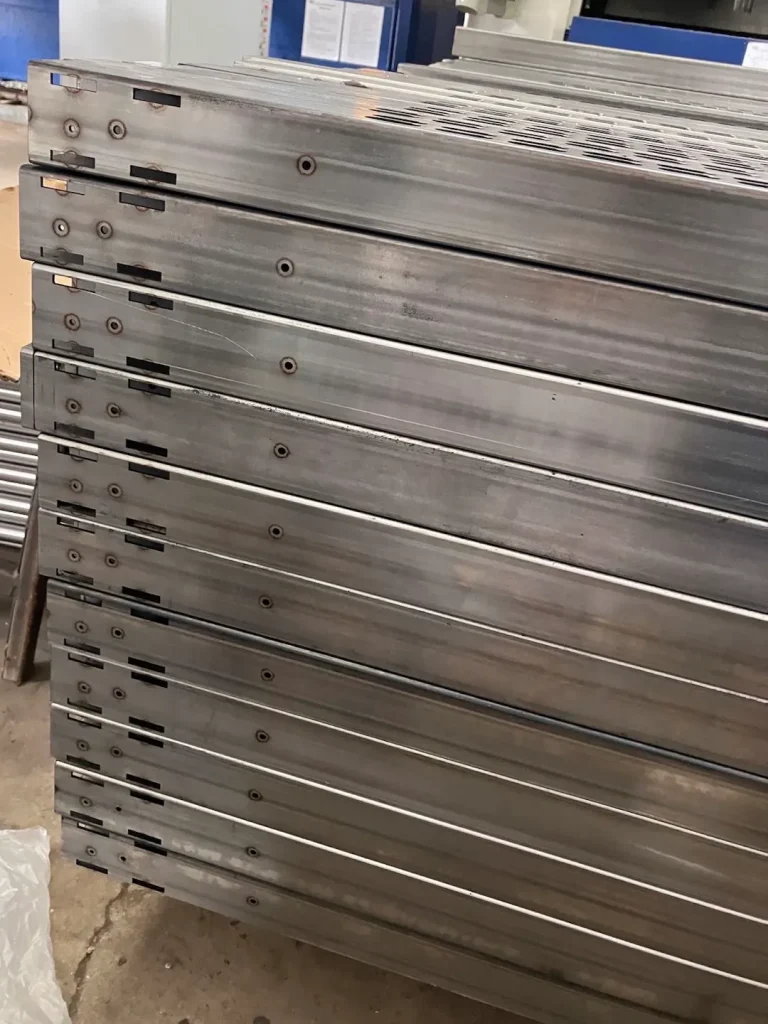Inhaltsverzeichnis
Überblick & Anwendungsfälle
Fähige Hardware bietet Produktionsqualität Faserlaserschnitt sowohl für Blech/Platte als auch für Röhrchen, in die Formierung integriert, Bearbeitung, Schweißen, Abschluss, und exportieren Verpackung. Für OEM/ODM -Käufer, Unsere Laserzellen liefern schnelles Prototyping und wiederholbares Volumen läuft mit sauberen Kanten und stabilen Abmessungen, die für die nachgelagerte Montage bereit sind Benutzerdefinierte Metallrahmen und automatisches Schweißen.
Warum diese Lösung für Präzision, Geschwindigkeit & Kostenkontrolle
Faserlaser schneiden die meisten technischen Metalle schnell mit minimaler Wärmezone ab (Gefahr). Unterstützte Gase (N₂/o₂/luft) und optimiertes Verschachteln reduzieren Schrott; Mikrogelenk und Ätzmarkierung Halten Sie Kits intakt und nachvollziehbar. Typische Schnittgenauigkeit ± 0,10–0,20 mm mit Kerbe ~ 0,10–0,30 mm Hilft den Ingenieuren, Baugruppenstapel ohne teure sekundäre Bearbeitung zu treffen.
Typische Branchen & Anwendungen
- Industrieausrüstung & Maschinen: Basisplatten, Wachen, Klammern, Servicestafeln.
- Lagerhaus/Logistik: Zwickel und Paneele für Karren/Racks (sehen /products/welding-trolley-carts/).
- Robotik & Automatisierung: Riserplatten, Zellpaneele, Aufleichterungsmuster, die sich sauber beugen.
- HLK/Elektrisch: Gehäuseplatten, perforierte Türen, COSBAR -Abdeckungen.
- Automobil/Landwirtschaft: Schleuderteller, Registerkarten, Chassis -Klammern, die für das Schweißen des Festes bereit sind.
Technische Eigenschaften
Materialien, Dickebereiche, schnitzen & Toleranzen (ISO 9013/ISO 2768)
- Kohlenstoffstahl: Q235/S235, Q355/S355, 0.8–25 mm
- Rostfrei: 304/316, 0.8–20 mm
- Aluminium: 5052/6061/6082, 0.8–15 mm
- Verzinkter Stahl: pro Beschichtungsklasse; Kantenqualität verifiziert nach dem Schnitt
- Bettgrößen: 1250× 2500, 1500×3000, 2000× 4000 mm
- Dimensional: typischerweise ± 0,10–0,20 mm (Merkmal/Geometrie abhängig) unter ISO 2768 m/f
- Schnittqualität: ISO 9013 Reichweite 2–4 (an Material/Dicke angeben)
- Schnitzen: ~ 0,10–0,30 mm Wird zur Nistung und Entschädigung verwendet
Einschränkungen & Design-für-Laser-Richtlinien (Minlöcher/Slots, Radien)
- Min -Loch Ø ≈ 1.0–1.2 × Materialstärke
- MIN Slot Breite ≈ Materialstärke + 0.2 mm
- Innerhalb Ecken: Fügen Sie kleine Filets hinzu, um die Wärmeweils und den Burr zu reduzieren
- Registerkarten/Brücken: Größe pro Dicke, um Teile im Blatt zu halten; in Deburr entfernt
- Common-Line-Schneiden: auf kompatible Merkmale erlaubt, um Burr/Wärme zu reduzieren
- Ätzmarkierung: Fügen Sie flache alphanumerische/Teil -IDs für das Ausrüster hinzu (Vermeidet Etiketten während der Verarbeitung)
Fertigungsoptionen
Gase schneiden (N₂/o₂/luft), nisten & Mikrogelenk; Deburr, klopfen, Gegenversinken
- Gas unterstützen:
- N₂ für kosmetische Edges aus rostfreiem/Aluminium
- O₂ Für den dickeren Kohlenstoffstahldurchsatz
- Luft Für kostenoptimierte Läufe (Kantenspezifikation bestätigen)
- Nisten: Ertrag optimierte Layouts mit KERF -Kompensation und Mikrogelenk Für Kit -Stabilität
- Vorbereitungsvorbereitung: Deburr/Chamfer, Gegenversinken, Tippen (M3 - M12 Typisch), Re -AMING von Präzisionslöchern
Sekundäre Ops: Biegung/Bildung, Bearbeitung, Schweißen; Beschichtung & Verpackung
- Bildung: Drücken Sie die Bremsbucken mit Biegungstabellen; flache Workflows
- CNC-Bearbeitung: Kritische Bohrungen/Gesichter bei GD&T erfordert enger als Laserspezifikation
- Schweißen: Handbuch/Robotermig (TIG, wenn angegeben) zu ISO 13920 B/c mit ISO 5817 Klasse C Standard (Klasse B für sichtbare Verbindungen), und ISO 2553 Schweißsymbole; sehen /services/automatic-welding/
- Abschluss: Pulvermantel (Ral, 70–100 µm), Zinkbeschichtung, E-Coat, Industriefarbe; Oberflächenvorbereitung auf ISO 8501, Beschichtungsauswahl nach Umwelt pro ISO 12944; sehen /services/powder-coating/
- Verpackung exportieren: Palette/Kiste, einfreudig, um Oberflächen zu schützen, Beschriftete Kits mit Barcodes und Stückzahlen für die Linienanordnung
Typen & Geometrie
Gemeinsame Teilfamilien (Klammern, Tafeln, Zwickel, Basisplatten, Perforationen) & Blattbänder
- Flache Panels & Türen (≤2000 × 4000 mm) mit Läden/Perforationen
- Winkelklammern & Zwickel mit Reliefs, die sich nach dem Schneiden sauber biegen
- Basisplatten mit Schlitz/Lochmustern für einstellbare Montage
- Perforierte Wachen & Bildschirme mit abgestimmten Verhältnissen der offenen Fläche
- Ausgestattete Leerzeichen Für Frames/Karren, die zum Bücken/Schweißen fortfahren
Qualität & Testen
Was wir überprüfen (Dimensionsprüfung, Kantenqualität; DFT zu ISO 2808) und Dokumentation (Kok, Inspektionsberichte)
- In-Prozess: Dimensionalprüfungen gegen DXF/DWG, Edge Burr & Haz Review, Flachness -Probenahme für große Teller
- Nach Abschluss: DFT gemessen an ISO 2808, Adhäsionsprüfungen wie angegeben
- Unterlagen: Kok, Inspektionsberichte, Materialverfolgbarkeit und Losetiketten.

Faserlaserschneidstahl 2 mm, N₂ Assist, Saubere Kante
Preisgestaltung & Vorlaufzeit
MOQ, Beispielrichtlinie, Indikative Kostenfahrer (Keine harten Preise)
- MOQ: flexibel; Prototypen lose akzeptiert, um sich zu beweisen, Anpassung/Form/Funktion zu beweisen
- Proben: Turn-Turn-Laser-Leerzeichen erhältlich vor dem Bildung/Schweißen erhältlich
- Vorlaufzeit: Schnelle Prototypen in Tagen; Produktionslose typischerweise 1–3 Wochen Abhängig von der Bildung/Schweiß-/Finish -Warteschlangen
- Kosten Treiber: Materialqualität/Dicke, Blattauslastung (Nestertrag), Teilzahl und durchbohrt, Gas unterstützen, Toleranzklasse, Deburr -Ebene, Klopflöcher/Countersinks, Schritte bilden, Schweißlänge, Beschichtungstyp/DFT, und Verpackungsspezifikation
Standards & Einhaltung
Relevante Standards/Zertifizierungen & Dokumentation bereitgestellt (ISO 9013, ISO 2768, ISO 13920, ISO 2553, ISO 5817, ISO 12944, ISO 8501)
- Schnittqualität: ISO 9013
- Allgemeine Toleranzen: ISO 2768 m/f
- Schweißnahmherstellung: ISO 13920 B/c, ISO 2553 Symbole
- Schweißnaht Akzeptanz: ISO 5817 (Klasse C Standard, Klasse B für sichtbare Gelenke)
- Beschichtungen: ISO 12944 (Umweltkategorie) und Oberflächenvorbereitung ISO 8501
- Vollständige Inspektions-/Rückverfolgbarkeitspaket auf Anfrage erhältlich.
FAQ
Welche Metalle und Noten schneiden Sie??
Q235/S235, Q355/S355, 304/316 rostfrei, 5052/6061/6082 Aluminium, und verzinktem Stahl. Geben Sie den Finish -Zustand an (z.B., 2B, gebürstet) Wenn kosmetisch.
Welche Dickengrenzen gelten?
Typische Bereiche: Stahl 0,8–25 mm, Edelstahl 0,8–20 mm, Aluminium 0,8–15 mm. Wir werden die Schnittqualitätsklasse bestätigen (ISO 9013 2–4) durch Material und Dicke.
Welche Toleranzen sollte ich rufen?
Verwenden Sie ISO 2768-m/F für nicht kritische Merkmale; GD GD angeben&T für kritische Bohrungen/Gesichter. AS-Cut-Genauigkeit beträgt üblicherweise ± 0,10–0,20 mm mit Kerf ~ 0,10–0,30 mm.
Alle Designregeln für Löcher und Slots?
Min -Loch ~ 1,0–1,2 × Dicke; min Slot ≈ Dicke + 0.2 mm. Fügen Sie kleine Innenradien hinzu und vermeiden.
Kannst du dich biegen?, Schweißen, und Mantel nach dem Schneiden?
Ja - Bildung, Bearbeitung, MIG/TIG -Gäste 13920 mit ISO 5817 Annahme, und Pulvermantel/E-Coat/Zinkbeschichtung pro ISO 12944. Sehen /services/automatic-welding/ und /services/powder-coating/.
Was ist mit Rohrlaserschnitt??
Wir schneiden sowohl Blech- als auch Rohrprofile aus (Schlüssel, COPES, tab-and-slot für jig-freie Einstellung) und kann geschweißte Baugruppen zur Installation liefern.
Welche Dateien akzeptieren Sie??
DXF/DWG für flache Teile; Schritt/IGEs für gebildete/geschweißte Baugruppen. Material einbeziehen, Dicke, Menge, Toleranzen, beenden, und Verpackungsnotizen.
Laden Sie Ihre Zeichnung hoch, um ein schnelles zu bekommen, Engineered Zitat
Senden Sie DXF/DWG/Schritt mit Mengen- und Finish -Notizen. Wir werden das Feedback der Herstellbarkeitsfähigkeit zurückgeben, Nestertrag, und ein fester Zeitplan.